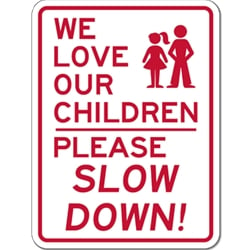
Strategically placed pedestrian crossing signs, such signs with pictorials of people walking or crossing the street are an effective way of reducing driver speed in residential communities as well as busy city streets. By making motorists aware that people may be crossing the street at an upcoming crosswalk or intersection, drivers can be better prepared to scan and slow down for these pedestrians. Moreover, a pedestrian crossing sign can help such pedestrians find a safer place to cross the street while minding traffic laws.
Pedestrian Crossing Signs Increase Awareness for Drivers
A report by the Federal Highway Administration discussed how crosswalks marked with pedestrian crossing sign and then paired with raised medians or crossing islands (sometimes called pedestrian refuges) reduce accidents the most. When roadways are modified with raised walkways or roundabouts, caution signs for pedestrians are more difficult for drivers to ignore.
While the Highway Administration concedes that more attention must be given to address the safety concerns of walkers, installing crossing islands, better traffic lighting, or curb extensions can be costly. Standalone caution warning signs, while perhaps not as effective on their own as they are with these infrastructure changes, can still help increase alertness and visibility for pedestrians.
Caution Warning Signs Keep Drivers Alert and Aware
A pedestrian crossing sign should be posted in places where pedestrians are known to cross particularly if there have been accidents at a particular intersection or place in the road. If costs permit, installing pedestrian crossing signs with traffic calming devices such speed bumps and curb extensions can help better remind motorists in residential neighborhoods to slow down. When drivers are more alert to the possibility of people crossing the street, they are likely to not only drive more slowly but also be more alert. Accidents caused by slow drivers tend to have better outcomes than accidents caused by drivers going too fast.

